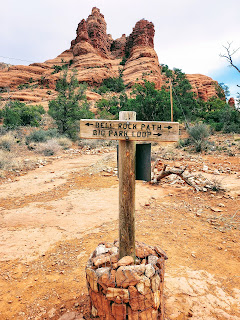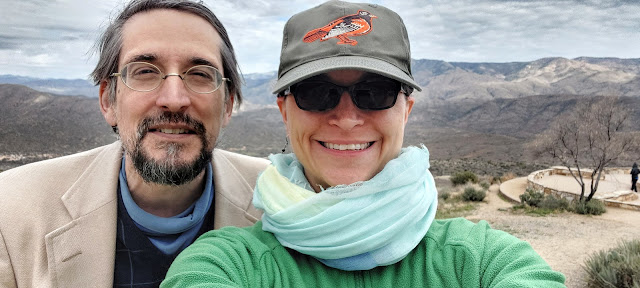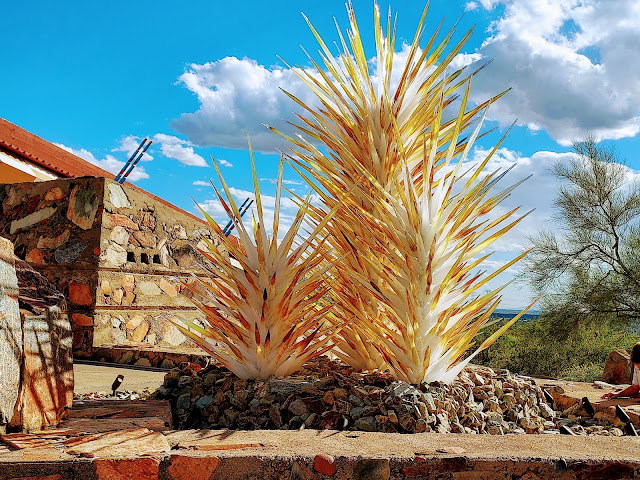While visiting the Southwest, I wanted to make sure we learned about the local/relocated Native American people. So after the archeological site of Pueblo Grande, we spent a good four hours in the award-winning Heard Museum. It is named for Dwight and Maie [sic] Bartlett Heard, who donated their collection of artifacts in 1929. The campus has grown since then to a cluster of Spanish colonial-style buildings around several courtyards and clustered with statuary. Dear Husband and I just missed their annual arts and crafts festival by a few days.
We started with Away from Home: American Indian Boarding School Stories and then ate lunch while digesting our sorrow. You have probably heard Richard Pratt's 1892 pronouncement, "Kill the Indian in him, and save the man." While that sounds more liberal than General Philip Sheridan's (re-written) 1869 comment, "The only good Indian is a dead Indian," it represents a nasty kind of progressivism that allowed that Native Americans could be educated; however, this was cultural and actual genocide by a different name, as Pratt acknowledged that it was cheaper to educate Native children than to kill them in military actions; plus, because the schools were located off the reservations, that money was injected into the local White economy.
On the left, an old-fashioned barber chair surrounded by long black braids; the sound of scissors played on a speaker. On the right, medical equipment for treating the tuberculosis that often ran rampant through the schools (you can see gravestones reflected in the glass of the display case).
The goal of the more than 350 government- and church-run schools was assimilation with White society; however, as one of the exhibit's interviewees pointed out, many different groups of new or "non-American" people were targeted for assimilation in the late 1800s without having their children stolen or coerced to be sent sometimes hundreds or thousands of miles away for years on end. This wasn't just about raising Christian Americans, it was about removing them from the land and the land from them. (Pratt said as much in that speech as well.) More than 100,000 children over 6 generations were persecuted for speaking their languages and practicing their religions; tens of thousands never returned home.
However, it is also true that from the mid-20th century, as the boarding schools came under increasing control of Native American teachers, students, and tribes, their meaning changed to include the fact that some students experienced them as places to solidify their "Indian" identity across reservation and tribal boundaries, such that they could lobby the federal government together for what they collectively needed (e.g. more funding for schools and the Native Health Service). Most of the schools closed in the 1980s after the Indian Self-Determination and Education Assistance Act was passed in 1975. Native art was (eventually) encouraged, and some families attend the same school generation after generation.
Tony Jojola (1958- ) and Rosemary Lonewolf (1953- ), both Santa Clara Tewa, "Indigenous Evolution" (2004), a mixed media fence of metal, ceramic, glass, etc.
Next up was their HOME: Native People in the Southwest exhibition about the 22 tribes in and around Arizona, in their own words and through artefacts such as pottery, baskets, and clothing. This first photo is from the Pueblo section.
Finally, we admired the "Grand Procession" of Plains-Indian "dolls," aka "soft statues" by Jamie Okuma (Luiseño and Shoshone-Bannock), Rhonda Holy Bear (Cheyenne River Sioux and Lakota) and three generations of Growing Thunder family members; Joyce Growing Thunder, Juanita Growing Thunder Fogarty and Jessa Rae Growing Thunder (Assiniboine and Sioux. These were exquisitely detailed, requiring thousands of hours of stitching and beading and quilling.
That was one of several special exhibits; we didn't get a chance to look at the one on silver jewelry, 19th-century depictions of Native tribes, or of contemporary Native art. For more photos, click here.



































































